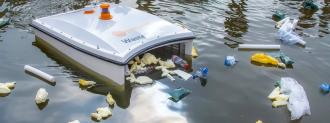New designs in autonomous boats, and a trash wheel that intercepts drifting trash, act as on-the-water trash-eating machines.
With marine debris a growing concern, innovators are getting creative — designing autonomous boats that act as on-the-water trash-eating machines.
The latest development comes from the Danish company RanMarine Technology. They’ve created an aquadrone called WasteShark that sucks up waste from the water much like a Roomba — consuming up to 200 liters of garbage in a single ride.
Autonomous Trash-Eating Vessels
The tiny autonomous vessel is already sailing around the Danish city of Århus, cruising the rivers, collecting trash, and bringing it to shore. The aquadrone can even recharge its battery all on its own.
As if that wasn’t enough, the company is adding a companion autonomous vehicle to help WasteShark identify trash — a flying drone. Together, they will make a supercharged sailing, flying, trash-eating duo.
“We’re testing a technology that can be scaled in a lot of different ways,” Martin Skjold Grøntved, a special consultant for the Danish Climate Ministry, told Fast Company.
The flying drone is equipped with a unique lens that collects data as it scans the waterways. A machine-learning algorithm learns to recognize floating plastic and trash, then guides the WasteShark to pick it up.
Water pollution has become a significant issue, mainly as plastic waste accumulates on the surface of bodies of water, posing a threat to both marine and human life.
With the flying drone’s added assistance, the trash-eating boat can now “see” oil spills — something it otherwise wasn’t able to identify. The pair can now work together to identify oil spills and use a special filter to clean them up.
The same startup that designed the data-collection algorithm for WasteShark also worked with the San Francisco Estuary Institute to use machine learning to understand the impact of waste-prevention initiatives, according to Fast Company. They created a project that tracks the amount of waste flowing into waterways with drones.
“Nonprofits have only so many people to put towards these efforts. And it’s a very time-intensive process to go out and just do the cleanups, first of all, let alone to count the amount of trash and then characterize it by certain categories. What this drone-based and machine learning-based method offers is a way to expand the geography,” said Tony Hale, program director for environmental informatics at the San Francisco Estuary Institute.
WasteShark isn’t the only autonomous trash-chomping boat: Baltimore’s Trash Wheel, a water wheel that intercepts trash, is a local icon. It just added a new member to the Trash Wheel family: Gwynnda the Good Wheel of the West. If the name sounds too cutesy to be taken seriously, think again. The first trash wheel appeared in Baltimore more than a decade ago — Mr. Trash Wheel — and has since become a local treasure and tourist destination. Mr. Trash Wheel even has its own popular Twitter profile.
How Does the Trash Wheel Work?
John Kellett was moved to action when he saw the heaps of trash in Baltimore harbor. His company, Clearwater Mills LLC, constructed the first trash wheel.
“I was constantly confronted with the fact that Baltimore has a beautiful harbor, but trash was a major problem and an impediment to people enjoying the harbor,” Kellett told Chesapeake Bay Magazine.
Powered by water wheels and solar cells, the members of the Trash Wheel family act as “trash interceptors,” collecting garbage from the water and transporting it via a conveyor belt to the ship’s dumpsters. And, best of all, they are all adorned with five-foot-tall googly-eyes — who says collecting trash can’t be fun?
We’d love to hear from you! If you have a comment about this article or if you have a tip for a future Freethink story, please email us at [email protected].





